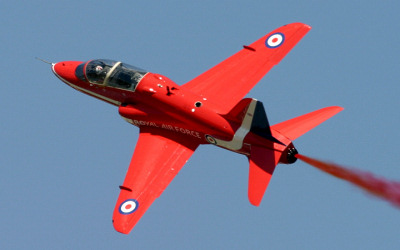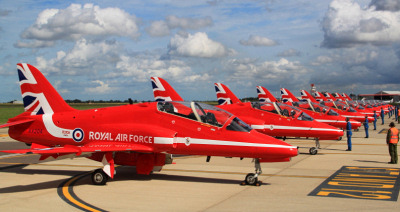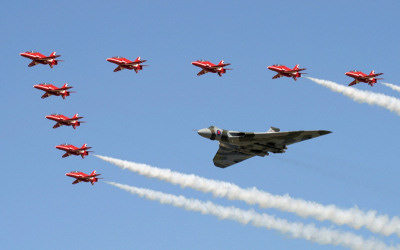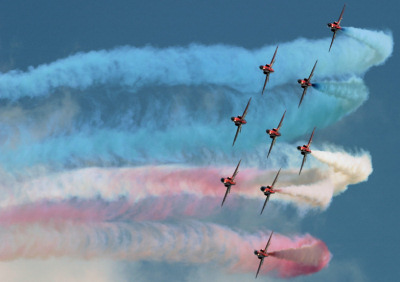RAF Scampton is located north of Lincoln in Lincolnshire, and was home to the Royal Air Force Aerobatic Team, the Red Arrows, which were the only permanent aircraft presently based here. More information here on the Red Arrows including Trackers & Timings. RAF Scampton hosted a two-day airshow in September 2017.
In July 2018, the Ministry of Defence announced that RAF Scampton would close by 2022 and be sold, with all units relocated elsewhere.
The Red Arrows relocated to RAF Waddington in October 2022.
RAF Scampton Satellite View
Military Aircraft Tracker in the UK
 • Current Military Aircraft in the UK Tracker.
• Current Military Aircraft in the UK Tracker.
• Historic Military Aircraft in the UK Tracker.
• Military Aircraft around the World Tracker.
Live Trackers
When using ADS-B Exchange Tracker then click on 'U' to see military aircraft.
Scanner Frequencies
RAF Scampton Scanner Frequencies
CAC (Swanwick Mil) - 259.600, 270.050
SRE (Waddington Approach) - 345.075
SRA (Talkdown) - 251.525
Tower - 340.675, 122.100
Ground - 336.525
Red Arrows Air to Air - 243.450
|
Military Aircraft Photographs at UK Military Bases
Aircraft & Squadrons
The Royal Air Force Aerobatic Team (RAFAT), the
Red Arrows were the only permanent aircraft based at RAF Scampton until October 2022 when they relocated to RAF Waddington. One of the premier aerobatic teams in the world, the Red Arrows are the public face of the Royal Air Force and are ambassadors for the United Kingdom. They operate the Hawk T1 aircraft and can be seen at many airshows and events in the UK and abroad.
Despite the Hawk T1 aircraft being retired on 31 March 2022, the Red Arrows are expected to continue to fly this aircraft until 2030.
Scampton also plays host to
'The RAF Scampton Heritage Centre', a small museum that acknowledges the Stations historical past, with exhibitions covering the famous "Dambuster" Raids, the First and Second World War heritage and all aspects of service activity from the 1960's to date.
The station was also home to private companies such as Hawker Hunter Aviation Ltd whose aircraft can operate on the UK military register and are flown & maintained by former RAF, RN & Test Pilot personnel. Their aircraft include Hawker Hunters, a Buccaneer and a Sukhoi Su-22. They can be used as Aggressor aircraft, Targets for surface units, Army support roles, and Target towing. With the closing of RAF Scampton, the HHA Hunters have been moved to RAF Leeming (Sept 2022).
There was an RAF Scampton Closing Ceremony on 5th September 2022 and the Red Arrows left RAF Scampton for their new home at RAF Waddington on Tuesday 27.9.22.
History
Home Defence Flight Station Brattleby was opened on the site of the current RAF Scampton in 1916 and operated FE2bs to defend against the Zeppelin threat. It was later used as a training aerodrome with the Sopwith Camel and Sopwith Dolphin. It was named Scampton in 1917 and then designated as 34 Training Depot Station before closing in 1919.
It was reopened in 1936 as RAF Scampton, after being constructed to the latest specifications, to become a Bomber Station, operating the Handley Page Heyford and Vickers Virginia. It later operated the Hawker Audax, Vickers Wellesley, Hawker Hind, and Handley Page Hampden.
During the Second World War, Scampton transferred to No.5 Group RAF in Bomber Command with Handley Page Hampden aircraft. Scampton was also base to the Avro Manchester for a short time before converting to the Avro Lancaster.
617 Squadron 'Squadron X' was formed at Scampton, following the development of the 'upkeep' bouncing bomb, to carry out the 'Dambusters Raid' (Operation Chastise). The operation was carried out on the night of 16-17 May 1943, with 19 Lancasters from 617 Sqn, commanded by Wing Commander Guy Gibson, who attacked the Sorpe, Eder and Mohne dams. The Eder and Mohne dams were breached, however 8 Lancasters failed to return home and 53 aircrew were lost. Following the raid Wing Commander Gibson was awarded the Victoria Cross.
The airfield closed at the end of August 1943 and three concrete runways were laid. Control of the station passed from 5 Group to 1 Group and Scampton was home to 1690 Bomber Defence Training Flight in 1944 with Spitfires, Hurricanes, and Martinets, and Lancaster bombers also arriving. At the end of the war, Scampton continued operating the Lancaster and later the Avro Lincoln.
The USAF 28th Bomber Group housed Boeing Washingtons at Scampton in 1948 but the base was handed back to the RAF in 1949 as the base was not ideally suited for the Washington aircraft. In 1953, Scampton became a Master Diversion Airfield and supported four Canberra Squadrons. The Canberras moved out in 1955 and the base for earmarked as a V-bomber base.
RAF Scampton was selected to accommodate part of the V-force and operated the Avro Vulcan. This required new ground facilities, a high security area for the storage and maintenance of nuclear weapons, and heavy duty hardstandings for the aircraft. The first atom bombs arrived in 1958 called 'Rainbow Code' and 'Blue Danube'. They were replaced by thermonuclear weapons called 'Yellow Sun'. The 'Blue Steel' stand-off nuclear missile was developed after the construction of specialist buildings at Scampton. The runway was extended to 9,000ft and a new control tower built.
617 Squadron reformed and were based at Scampton in 1958 with Vulcan bombers. By 1963, the Scampton Wing was formed with 3 Sqadrons of Vulcans equipped with the Blue Steel nuclear missile. In 1968, Blue Steel operations ceased at Scampton with the Royal Navy assuming responsibility for the nuclear deterrent with their nuclear submarines and Polaris missiles.
With the cessation of 617 Squadron's Vulcan operations in 1981, Scampton transferred to RAF Support Command and was home to the Central Flying School in 1983, operating the Bulldog, Tucano, and the Red Arrows. In the mid 1990s, Scampton was mothballed and the base was to have been closed, however due to strong opposition, it remained open. In 2005, Scampton was placed under control of RAF Strike Command and became home to the UK Air Surveillance and Control System (ASACS) Control and Reporting Centre (CRC) and Mobile Met Unit (MMU). In 2008, the future of Scampton was again under threat but operations in Libya put the desion on hold. In 2011, a review concluded that keeping the Red Arrows at RAF Scampton was the best way for them to operate, without affecting other operational flying bases, and the runway was resurfaced to ensure that Scampton would be retained as an operational flying base.
The RAF Charitable Trust announced on 19th February 2016 that it had reached an agreement in principle with the Royal Air Force to organise an
air show at RAF Scampton as early as September 2017. The
RAF Waddington International Air Show was scrapped as a result of a Ministry of Defence review during 2015 which also concluded that RAF Scampton was an ideal location for a show. Unfortunately, the air show will not take place in 2018 as the organisers fully consider the many lessons learnt in 2017, with the ambition of running an event in 2019.
It has been announced that RAF Scampton will close by 2022. The station was due to close in 2014 but in June 2012 the Ministry of Defence confirmed the Red Arrows would remain there until at least the end of the decade. In July 2018, the MoD announced that Scampton would close by 2022 and be sold, with all units relocated elsewhere. In March 2019, the Ministry of Defence indicated that
RAF Waddington,
RAF Leeming and
RAF Wittering were being considered as the future home of the RAF Aerobatic Team the Red Arrows. In May 2020 it was announced that the Red Arrows would be based at RAF Waddington and relocation will take place before RAF Scampton closes in late 2022. The airspace over RAF Scampton will be retained for the team's training and display practice.
In July 2018, the Ministry of Defence announced that RAF Scampton would close by 2022 and be sold, with all units relocated elsewhere.



 Red Arrows - John Bilcliffe.
Red Arrows - John Bilcliffe.
 Red Arrows & Vulcan.
Red Arrows & Vulcan.
 Red Arrow.
Red Arrow.
 Red Arrow.
Red Arrow.